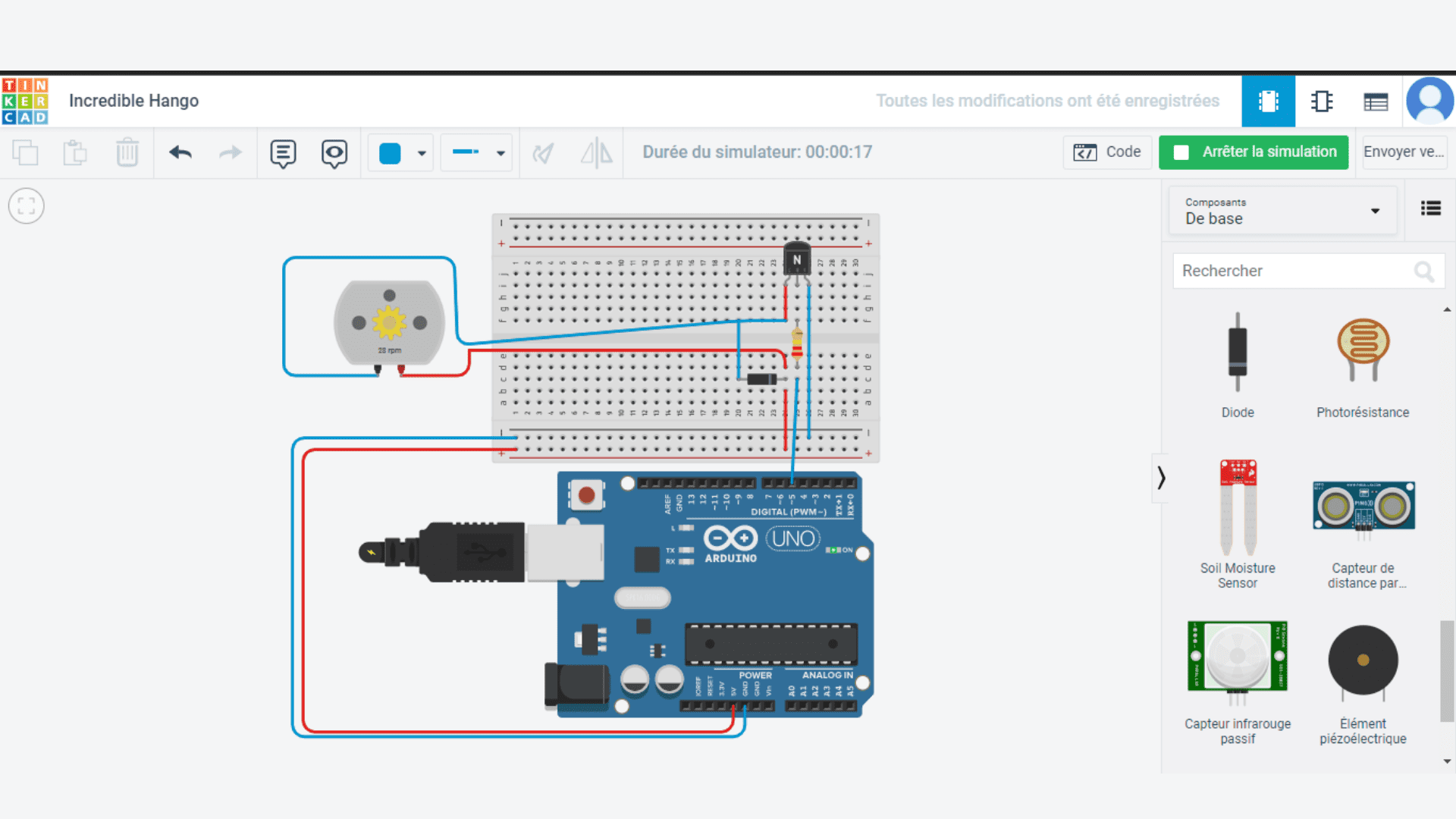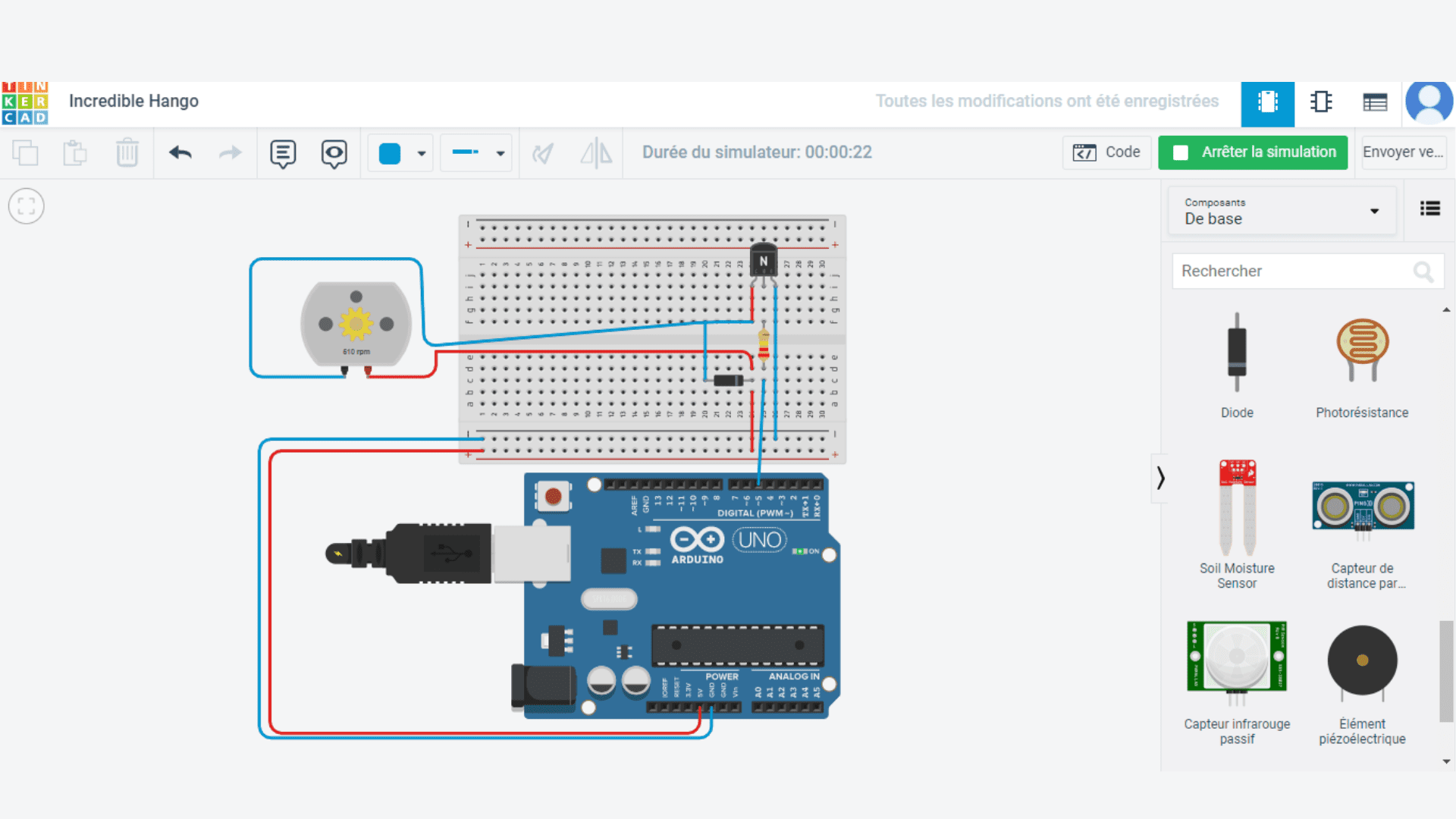Introduction
DC motors are electric motors powered by the current.
Many applications and toys and Arduino projects use DC motors. In the Article, EStarter DC Motor Arduino Uno project we will explain the easiest way to use the DC motor in an Arduino Uno project.
What are DC Motors
DC motors are the electric motor that converts electrical energy into mechanical energy. DC motors are a considerably common type of electric motor because they are relatively simple, inexpensive, and easy to control. DC motors can be either brushed or brushless.
Brushed DC motors have a rotor with permanent magnets that interact with the stator’s electromagnets to create rotation. A series of switches control the electromagnets called brushes that periodically interrupt current flow in the coils around the stator.
Brushless DC motors use Hall sensors to detect which way the rotor is turning and adjust its magnetic field accordingly.

What are they, and what does a DC Motor do?
DC motors are electric motors that convert electrical energy into mechanical energy.A DC motor typically consists of a stator and a rotor. The stator is the stationary part, which has coils of wire wound around it.
The rotor is the rotating part, typically made up of electromagnets and permanent magnets. When an electric current flows through the coils, they generate a magnetic field that interacts with the permanent magnets on the rotor to make it spin.
Different Types of DC Motors
DC motors are electric motors that use direct current to create rotational motion. They are the most widely used electric motor and come in various shapes, sizes, and power ratings.
There are various types of DC motors, but they can be broadly classified into three categories:
- Brushless DC Motor
- Brushed DC Motor
- Stepper motors
Brushless DC Motor
Brushless DC motors are a type of motor that does not use a commutator (or brushes) to control the power delivered to the rotor.
A brushless DC motor has an electronic controller which takes care of the timing and power distribution among the windings. Brushless DC motors are more efficient than brushed DC motors because they eliminate brush contact and wear and provide better torque density.
Brushed DC Motor
Brushed DC motors are the most common electric motor in use today. They are used in almost all modern vehicles and many other applications.
A brushed DC motor has two brushes: one set to transfer current to the rotor and one set to collect current from the stator windings. The brushes contact a spinning shaft, which moves power from the battery or other power source to the motor’s rotor.
Since brushed DC motors have a limited lifetime, they must be replaced periodically for optimal performance.
Stepper motors
Stepper motors convert electrical energy into mechanical energy in the form of a rotating shaft. They power many modern devices, including printers, disk drives, and computer fans.
The essential components of a DC motor
The essential components of a DC motor are:
– Stator: The stationary part that provides the magnetic field and contains the windings.- Rotor: The rotating part is acted upon by the magnetic field and turns with rotation.- Armature: A conductive coil wound around an iron core (the armature).- Brushes: Conductive parts that transfer electrical energy from stationary to rotating parts, for example, by touching them together to transfer electric charge from one to the other.
What are the Benefits of Using a DC Motor?
DC motors are the most commonly used type of electric motor.
They’re great for applications that need variable speeds. DC motors have a rotor (a spinning arm) and stator (a stationary arm).
The stator is made up of an electromagnet, and the rotor is made up of a permanent magnet. With this setup, the magnets repel each other until the electromagnet turns off, releasing.
DC motors are in a variety of applications.
They are used in washing machines, printers, conveyor belts, etc. These motors work by spinning when powered. Each type of DC motor has a specific operating speed and a voltage range in which it can function.
The most common type of DC motor is the three-phase induction motor found in almost all applications requiring rotational motion.
What are the Disadvantages of Using a DC Motor?
-DC motors can be used in many different applications, but some disadvantages come with using them. DC motors are not very efficient, and they require a lot of maintenance.
They also have low torque and high speed, making them difficult to control.
-DC motors are not as efficient as AC motors.This is because they use a direct current where the current produces the magnetic field in one direction. This means that they are always in one position, and it is not possible to have varying speeds.
-The torque of DC motors decreases when the speed increases. This means that they are not suitable for applications where speed must be maintained at all times, such as a washing machine or vacuum cleaner.
Dc motor and Arduino board
If you have a dc motor and want to use it with an Arduino board, you need to know that the two are incompatible. You will need to use a relay, motor driver, or transistor to connect them.
Some electronic components need to be dealt with during the completion of a DC Arduino project.
NPN transistor
The NPN transistor is a semiconductor device that amplifies current. It has three terminals: collector, base, and emitter.
The NPN transistor is a current amplifier because it can amplify the current from the collector to the emitter when there is a slight voltage difference between the base and emitter.

MOSFET transistor
The MOSFET is a four-layer device that consists of three terminals, the source, gate, and drain.The gate terminal is located between the source and drain terminals.
The gate terminal controls whether or not current can flow from the source to the drain.
When voltage is applied to the gate terminal, it creates an electric field that causes electrons to flow from the source to the drain through a channel created by an insulator (usually silicon dioxide).
L298 H bridge
The L298 H-bridge is a very commonly used circuit in robotics and other electronic projects. The L298 H bridge is composed of 4 parts: the two power supplies, the two motor drivers, and the feedback resistor.
The power supply provides a regulated voltage to both sides of the bridge circuit. The motor driver on each side controls one direction of current flow by applying a voltage to either one or both of its inputs – depending on whether it’s being used as an inverter or not.
The feedback resistor monitors how much voltage has been applied to each input so that it can provide an accurate reading back to the PC so the software can make decisions based on this data.
The potentiometer and feedback resistor are connected to a digital input on the I/O connector of the ATmega328 microcontroller. We will use this transistor because this feature is for advanced Arduino projects.
Diode component
A diode is a semiconductor device that can only conduct electricity in one direction. Diodes are used to rectify alternating current or isolate two circuits from each other.
A diode can be made from various materials, but silicon diodes are the most common. Silicon diodes are created by placing a piece of silicon between two electrical contacts and applying a voltage across them.
The semiconductor material has an excess of electrons on one side, so when the voltage is used, the electrons will flow through the material in the direction that has less resistance (the forward direction).
Tinkercad Starter DC Motor Arduino Uno project
Motor speed control
The components needed
- Arduino Uno board
- Breadboard
- Four red jumper wire
- Four blue jumper wire
- DC Motor
- Diode
- 220-ohm Resistor
- Transistor NPN
Description of the project
In the beginning, we will control the speed of the DC motor: We can increase and decrease the speed of the DC motor.
Be aware that the highest speed of the DC motor is 250, and the lowest DC speed of the motor is 0.

The code of the project
// C++ codeint dcMotor = 5;void setup(){pinMode(dcMotor, OUTPUT);}
void loop(){int MotorSpeedControl = 10;analogWrite(dcMotor,MotorSpeedControl);delay(80);}
The code of the project: increase the speed of the motor.
// C++ codeint dcMotor = 5;void setup(){pinMode(dcMotor, OUTPUT);}
void loop(){int MotorSpeedControl = 180;analogWrite(dcMotor,MotorSpeedControl);delay(150);}

Take notice

We saw the easiest way to control the speed of the DC motor with an Arduino board.Make the DC motor run regularly with an Arduino Uno program.
The components needed
- Arduino Uno board
- Breadboard
- Four red jumper wire
- Four blue jumper wire
- DC Motor
- Diode
- 220-ohm Resistor
- Transistor NPN
Description of the project
We run the motor using the Arduino Uno program once and make it stop working once, with a specific delay time. It will be easy to observe the working state and the stop working condition.// C++ codeint dcMotor = 5;void setup(){pinMode(dcMotor, OUTPUT);}
void loop(){digitalWrite(dcMotor, HIGH);delay(3000); digitalWrite(dcMotor, LOW);delay(1000); }

Conclusion

Conclusion
In conclusion, the DC motor is a type of electric motor that uses direct current (DC) to drive the rotor.
The simple construction and lack of brushes mean that they are easy to maintain and have no complex commutator.
This article saw the most straightforward program to drive a DC motor with Arduino Uno.
